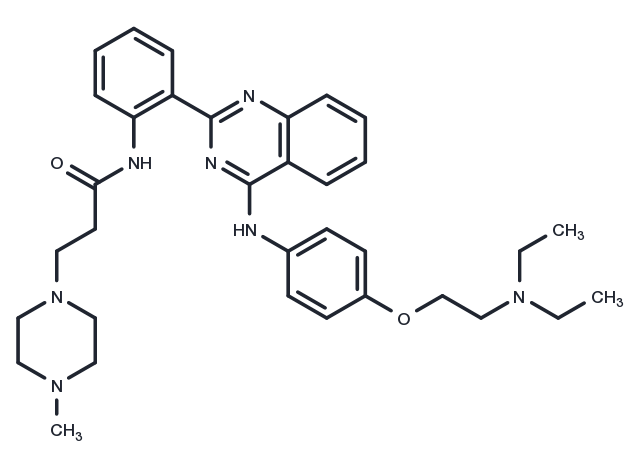Powder: -20°C for 3 years | In solvent: -80°C for 1 year


hVEGF-IN-1 inhibits human VEGF-A translation and has antitumor activity.

| Pack Size | Availability | Price/USD | Quantity |
|---|---|---|---|
| 1 mg | In stock | $ 97.00 | |
| 5 mg | In stock | $ 222.00 | |
| 10 mg | In stock | $ 313.00 | |
| 25 mg | In stock | $ 529.00 | |
| 50 mg | In stock | $ 765.00 | |
| 100 mg | In stock | $ 1,070.00 | |
| 500 mg | In stock | $ 2,150.00 | |
| 1 mL * 10 mM (in DMSO) | In stock | $ 285.00 |




| Description | hVEGF-IN-1 inhibits human VEGF-A translation and has antitumor activity. |
| In vitro | hVEGF-IN-1 has a markedly selective interaction with the G-rich region within the 5′-UTR of hVEGF-A mRNA and destabilizes the G-quadruplex structure. hVEGF-IN-1 binds to the IRES-A (WT) (Kd: 0.928 μM) and binds to the hairpin DNA (Kd: 21.2 μM). The G-rich sequence G774-G790 within the IRES-A of hVEGF-A's 5′-UTR is critical for the translation initiation activity of IRES-A. hVEGF-IN-1 hinders BG4 from binding to the IRES-A RNA G-quadruplex in cells. hVEGF-IN-1 down-regulates the translation of hVEGF-A via the G-quadruplex within IRES-A mRNA. hVEGF-IN-1 reduces MDA-MB- 231 cell migration to about 25%. |
| In vivo | In tumor-bearing mice, hVEGF-IN-1 causes an average tumor volume of fewer than 300 mm3. In the presence of hVEGF-IN-1, the tumor weight reduces around 60.1% to a final weight of 0.18 g and no obvious change in body weight. |
| Cell Research | MDA-MB-231 cells are plated in the top chambers of 0.8 μm pore trans-wells in Opti-MEM reduced serum medium in the presence or absence of hVEGF-IN-1. Meanwhile, 600 μL of DMEM containing 10% fetal bovine serum (FBS) and 100 μM CoCl2 are added to the lower chambers. The cells are allowed to migrate for 24 h. At the end of the assay, the cells in the top chamber are removed, and the cells at the bottom of the filter are treated by adding 500 μL of DMEM containing 2.5 mg/mL MTT to each well. After incubating at 37 °C with 5% CO2 for 4 h, 500 μL of DMSO is added to each well and the plate is gently rotated for 10 min. Absorbance (570 nm) is measured using a microplate reader. |
| Animal Research | Mice are separated into three groups: negative control, compound 1-treated, and positive control (doxorubicin-treated). hVEGF-IN-1, doxorubicin, and saline are administered by intraperitoneal injection to athymic nude mice with human tumor xenografts established using MCF-7 breast cancer cells. Mice are injected intraperitoneal once a day for 20 days. Negative controls are injected with 150 μL of saline. The positive control group received doxorubicin by intraperitoneal injection at a dose of 1 mg/kg. hVEGF-IN-1 is similarly administered to mice at a dose of 7.5 mg/kg. After treating the animals for 20 days, the tumor tissues are collected and IHC assays are conducted using an anti-VEGF-A antibody[1]. |
| Molecular Weight | 581.75 |
| Formula | C34H43N7O2 |
| CAS No. | 1637443-98-1 |
Powder: -20°C for 3 years | In solvent: -80°C for 1 year
DMSO: 5.82 mg/mL (10 mM)
You can also refer to dose conversion for different animals. More
bottom
Please see Inhibitor Handling Instructions for more frequently ask questions. Topics include: how to prepare stock solutions, how to store products, and cautions on cell-based assays & animal experiments, etc.
hVEGF-IN-1 1637443-98-1 Angiogenesis Tyrosine Kinase/Adaptors VEGFR Inhibitor quinazoline IRES-A migration hVEGF IN 1 hVEGFIN1 tumor G-rich inhibit Vascular endothelial growth factor receptor VEGF-A inhibitor
